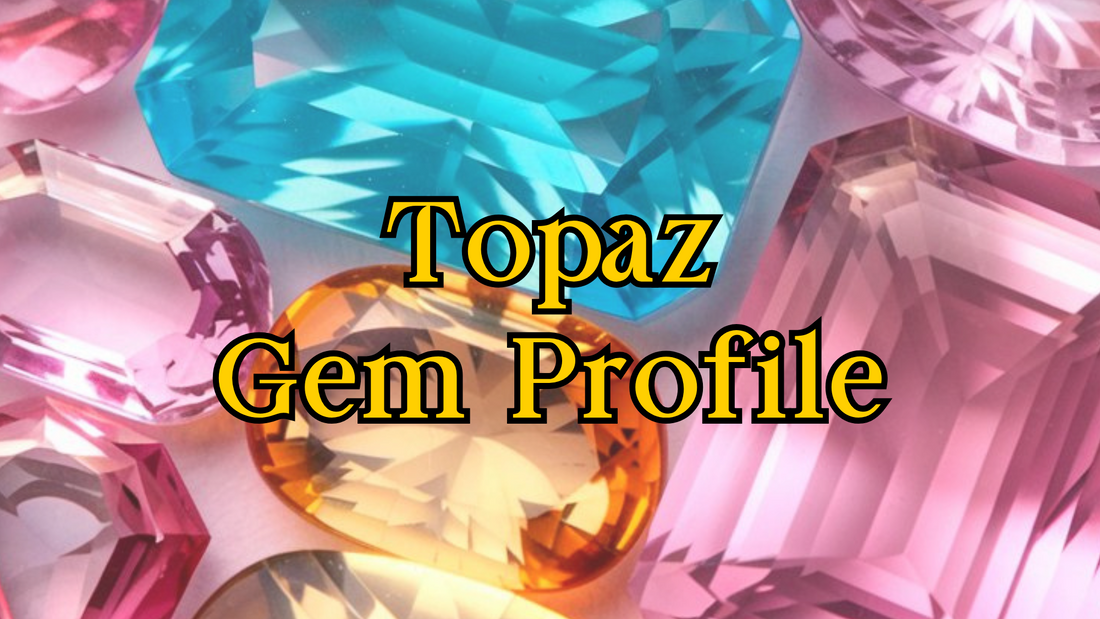
A Jeweller’s Guide to Topaz: Identification Tips and Jewellery Making Advice
Say hello to topaz, the chameleon of the gem world! From warm golden hues to icy blues and even blush pinks, topaz has a little something for everyone. Whether you’re creating a show-stopping cocktail ring or a dainty charm necklace, this gemstone adds an air of elegance to any design. With its impressive clarity, range of colours, and reasonable price point, it’s no wonder topaz has been a jeweller’s favourite for centuries. Ready to unearth the sparkling secrets of this versatile gem? Let’s dive in!
 Basic Identification Information
Basic Identification Information
- Name & Synonyms: Topaz; also known as "Imperial topaz" for its rare golden-orange variety.
- Species: Topaz
- Colour Range: Colourless, blue, yellow, orange, pink, purple, red, and brown. (Blue and colourless are most common in the market.)
- Refractive Index: 1.609–1.643
- Birefringence: 0.008 to 0.011
- Optical Sign: Biaxial+
- Specific Gravity: 3.49–3.57
- Fluorescence: None to weak (varies by colour).
- Lustre: Vitreous (brilliant and glassy when polished).
- Clarity: Type 1 – typically eye-clean, though inclusions may appear in rarer varieties.
- Gems often mistaken for topaz: Citrine, Spinel, Sapphire, aquamarine, or synthetic stones.
- Mohs Hardness: 8
- Wearability: Very good, but prone to cleavage if struck.
- Birthstone: November (alongside citrine)
 Common Treatments
Common Treatments
Many topaz stones, especially the popular Swiss and London blue varieties, owe their vibrant hues to irradiation followed by heat treatment. Pink topaz is often heat-treated from golden-yellow stones. These enhancements are standard practice in the gem trade and produce a stable colour.
Another common treatment with topaz is colour coating. The most striking example is mystic topaz, which mesmerises with its rainbow-like iridescence. This effect is created by applying a thin metallic coating, typically titanium, to the surface of colourless topaz. While the results are dazzling, this coating is delicate and prone to scratching or wearing off over time, especially on jewellery that experiences heavy wear.
 Durability Considerations
Durability Considerations
Topaz may score high on hardness, but it’s a bit of a diva when it comes to durability. It has perfect cleavage (a fancy way of saying it’s prone to splitting along certain lines if struck hard). While it’s suitable for everyday jewellery, make sure to treat it with care—think of it as a crystal slipper: gorgeous, but handle with caution.
 Jeweller's Setting Tips
Jeweller's Setting Tips
Topaz loves being the centre of attention in statement jewellery, but protective settings are a must. Bezel or halo designs are great options for rings to minimise the risk of damage. If you’re planning to cast it in place, remember: topaz and extreme heat do not mix. Better to set it post-casting to keep it safe and sparkly.
 Care Instructions
Care Instructions
Topaz is a gem that loves a gentle touch. Clean it with warm water, mild soap, and a soft brush. Skip the ultrasonic cleaners and steamers—they can cause fractures or even colour changes, especially when working with a stone that’s had heat and or irradiation treatments. Store your topaz jewellery separately to avoid scratches and keep it away from prolonged exposure to sunlight, which can fade its vibrant hues over time.
 Aesthetic & Design Insights
Aesthetic & Design Insights
With its wide colour palette, topaz can suit just about any design or metal type. Blue topaz pairs beautifully with silver or white gold for a cool, modern vibe, while golden or peachy topaz looks stunning in yellow gold for a warm, luxurious feel. Create contrast by pairing it with diamonds or use multiple topaz colours in one design for a playful, ombré effect.
 Market & Ethical Notes
Market & Ethical Notes
The price of topaz varies by colour and rarity. Imperial topaz (golden-orange to reddish-pink) is the most valuable, while blue topaz is more affordable due to its abundance and treatments. Thankfully, most topaz is ethically sourced, with Brazil and Russia being major suppliers.
 Metaphysical Properties
Metaphysical Properties
Topaz is often referred to as a "stone of manifestation," said to help bring dreams to life—whether that’s a creative project, a new opportunity, or finally perfecting your jewellery design. Blue topaz, in particular, is thought to enhance communication and clarity, while golden topaz (Imperial topaz) is said to inspire abundance and confidence. Basically, it’s your sparkling cheerleader in gemstone form.
To read more about the metaphysical properties of Topaz Click Here
 Fun Fact
Fun Fact
Did you know there is folklore that says in the Middle Ages people believed topaz could make you invisible? (Not a bad trick for sneaking away from awkward dinner parties!)
Interested in more Topaz facts? Click Here
